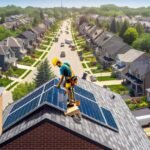Installing solar panels in Canada isn’t just about harnessing the sun’s power—timing is everything. While you might assume that summer is the best time, the reality is more nuanced. Did you know that snow-covered panels can significantly reduce efficiency, making winter installations less ideal? But what about the myths that cloud your judgment? Are solar panels truly ineffective in cloudy weather, or are you missing out on potential savings?
Surprisingly, solar panels can generate electricity even on overcast days, debunking one of the most common misconceptions. With a typical payback period of 5 to 10 years, timing your installation can make a significant difference in your return on investment. Ready to discover the best and worst times to install solar panels in Canada? Let’s immerse and separate fact from fiction.
Understanding Seasonal Impact
When considering installing solar panels in Canada, it’s crucial to understand how seasons can affect their performance and installation feasibility. Have you ever thought about how snow, shorter days, and extreme temperatures might play a role?
Winter Challenges
Winter might seem like the worst time to install solar panels. Snow accumulation can cover panels, blocking sunlight and reducing efficiency. Also, shorter days mean fewer daylight hours for energy generation. Homeowners might need to consider snow removal or automated panel cleaning systems.
 how to use canadian regulations for easy home solar panel installation
how to use canadian regulations for easy home solar panel installationSpring and Fall Considerations
Spring and fall offer milder conditions for installing solar panels. But, unpredictable weather, like heavy rain in spring or early snowfall in fall, could delay installation. But these seasons generally provide optimal sunlight without extreme temperatures, making them effective for both installation and energy production.
Summer Myths
Contrary to popular belief, summer isn’t always the best time for solar panel installation. While sunny days are abundant, extreme heat can reduce a panel’s efficiency. High temperatures can cause the system to overheat, limiting the amount of electricity generated. Surprisingly, mild temperatures actually enhance solar panel performance and longevity.
Optimizing Installation Time
Optimizing your installation time can maximize your return on investment. Most experts recommend late spring or early fall when the weather is stable and mild. This timing ensures that your solar panels are up and running before extreme temperatures (either hot or cold) start affecting performance.
Real-World Example
Consider a homeowner in Toronto planning to install solar panels. They scheduled their installation for late April, avoiding harsh winter conditions and unpredictable summer heat. By summer, their panels were fully operational, efficiently converting sunlight into electricity without the downsides of peak heat.
Read also: how to use canadian regulations for easy home solar panel installation
how to use canadian regulations for easy home solar panel installation from purchase to power: ultimate guide for canadian solar diyers
from purchase to power: ultimate guide for canadian solar diyersCurious about transforming your solar lifestyle? Visit Solar Panels for Life to explore our comprehensive guides and product offerings designed to optimize your energy solutions year-round.
The Worst Times To Install Solar Panels In Canada
Timing matters when installing solar panels. Canada offers unique challenges, and understanding them helps optimize your solar lifestyle investment.
Winter Conditions
Winter poses significant obstacles for solar panel installation. Heavy snowfall and freezing temperatures can delay installation projects and cause logistical headaches. Snow accumulation on roofs can make it nearly impossible to access certain areas, putting workers at risk and increasing labor costs. Also, shorter daylight hours mean less sunlight to harness, impacting the immediate performance of newly installed panels.
Do you really want to brave the cold? Imagine trying to install panels while battling icy winds and slippery surfaces. When winter strikes, you might find it takes weeks longer to complete what could be a straightforward installation in milder weather. It’s practical to plan for a time when conditions are more predictable to ensure the efficiency and safety of your project.
Read also: how to use canadian regulations for easy home solar panel installation
how to use canadian regulations for easy home solar panel installation from purchase to power: ultimate guide for canadian solar diyers
from purchase to power: ultimate guide for canadian solar diyers 10 mistakes canadians make in diy solar panel installation
10 mistakes canadians make in diy solar panel installationSpring Breakup
Spring breakup, the period when ice and snow melt, can also be a challenging time for solar panel installations. This season often brings muddied grounds and unpredictable weather patterns that contribute to installation delays. With fluctuating temperatures and frequent rain showers, roof surfaces may remain damp, making installation unsafe and less efficient.
Ever thought about what happens when everything thaws? During the spring breakup, roofs could be more susceptible to leaks, and the ground can become too unstable for scaffolding and ladders. These conditions not only prolong the installation process but could also lead to higher labor costs as workers need more time to navigate these obstacles. Why risk it when better conditions could be just around the corner? Waiting for late spring or early fall offers more stable environments for your solar panel project.
To stay ahead and make the most well-informed choice, consider the timing carefully. For more insights, visit Solar Panels for Life and explore how you can best harness the sun’s power year-round.
Better Installation Times And Why
Choosing the right time to install solar panels can save you headaches and money. While summer and winter both have their challenges, there are better times worth considering.
Read also: how to use canadian regulations for easy home solar panel installation
how to use canadian regulations for easy home solar panel installation from purchase to power: ultimate guide for canadian solar diyers
from purchase to power: ultimate guide for canadian solar diyers 10 mistakes canadians make in diy solar panel installation
10 mistakes canadians make in diy solar panel installation hidden costs of diy solar: what canadian homeowners must know
hidden costs of diy solar: what canadian homeowners must knowOptimal Summer Months
Summer might seem like the perfect time for solar panel installation, but it’s not always the best. Solar panels, contrary to popular belief, are less efficient in extreme heat. High temperatures can reduce the photovoltaic efficiency. But, the longer daylight hours are beneficial for installation. June and September are generally the best summer months for installation. By avoiding the peak summer heat, you maximize both the installation process and the efficiency of your panels. Imagine setting up your solar lifestyle without the sweltering summer temperatures getting in the way. That’s what you get by opting for the earlier or later summer months.
Early Fall Benefits
Early fall is arguably one of the best times for installing solar panels. The mild weather between late September and early October offers ideal conditions. You’ll avoid the high heat of summer and the unpredictable weather of spring. This period also ensures your panels are ready to generate energy before winter sets in. A customer of Solar Panels for Life, for instance, noted an increase in overall efficiency when they installed their panels in early October. Fall installations often mean fewer delays and lower labor costs, giving you a smooth transition into your solar lifestyle. Why wait till it’s inconvenient when early fall’s right around the corner?
Ready to explore more about perfect install times for your solar energy solutions? Jump into our expert insights on Solar Panels for Life and take the first step towards an efficient solar future.
Regional Considerations Across Canada
Different regions in Canada present unique challenges and opportunities for installing solar panels. Understanding these regional nuances ensures you optimize your solar lifestyle to achieve the best results.
Western Canada
Western Canada, including BC and Alberta, experiences diverse weather patterns that impact solar panel installation. Heavy snowfall in mountainous regions like the Rockies can cover panels, reducing efficiency. Timing your installation during the melt period, typically in April or May, avoids this issue while still allowing ample summer sunlight for energy capture.
Summer in Western Canada can be ideal due to the long daylight hours, but watch out for extreme heat waves, which hurt panel efficiency. Have you considered how summer wildfires might affect your installation plans? Smoke and ash can reduce sunlight absorption, making early summer a more optimal choice.
By scheduling your installation when the weather is stable, you’ll avoid delays and maximize your return on investment. Our example: a Calgary resident successfully installed their panels in late May, ensuring full summer sun exposure.
Eastern Canada
Eastern Canada, including Quebec and the Atlantic provinces, faces challenges like heavy snowfalls and intense winter storms. Scheduling installations from late April to early June when the weather is milder can help avoid these issues. The abundance of clear, sunny days during summer is another perk after spring’s unpredictable weather.
Fall is another fantastic option in Eastern Canada. With mild temperatures and fewer weather disruptions, late September through October offers a sweet spot for solar setups before winter hits hard. Why not take advantage of the harvest season and ensure your system works optimally before the harsh winter?
For instance, a Halifax homeowner chose early October for their installation, ensuring their solar panels were operational well before the first major snowfall. This strategic timing maximizes energy capture across the seasons and provides a smoother installation experience.
Are you curious about how to optimize your solar panel setup year-round? Explore our resources at Solar Panels for Life to find tailored advice and solutions for your Canadian solar needs.
Tips For Planning Your Solar Panel Installation
Planning your solar panel installation in Canada shouldn’t be daunting. With these tips, you can optimize your solar lifestyle and achieve the best results.
- Choose the Right Season
Fall offers mild temperatures and stable weather, making it ideal. Summer’s intense heat can reduce efficiency, while winter’s snow and shorter days present challenges. Aim for late September or early October to ensure optimal performance. - Understand Local Climate
Western Canada experiences heavy snowfall; so, the melt period in April or May is ideal. Eastern Canada has milder conditions from late April to early June or in fall. Research specific to your region ensures you pick the best possible time. - Consider Regional Challenges
Your location affects your installation schedule. For example, Calgary’s fluctuations are different from Halifax’s coastal conditions. Knowing these nuances can significantly impact your installation’s success. - Secure Permits Early
Permit processes vary by municipality and can take weeks. Starting early avoids unnecessary delays, ensuring you’re ready to install during your preferred season. - Explore Financing Options
Personal loans offer fixed rates and flexible terms, making them an excellent choice. Government incentives like tax credits and rebates also substantially reduce initial costs. Comb through local and federal programs to maximize savings. - Think Long-term
Though upfront costs can be high, solar panels lower electricity bills over time. The average Canadian installation costs between CAD 12,000 and CAD 25,000, with a payback period of 5 to 10 years. Investing now ensures long-term gains.
Why rush the process? A thoughtful plan leverages the best times, secures permits, and uses financial incentives. Ready to dive deeper into your solar journey? Visit Solar Panels for Life for comprehensive resources and expert advice.
Conclusion
Timing your solar panel installation in Canada is crucial for maximizing efficiency and return on investment. While winter and spring breakup present significant challenges, late spring and early fall offer optimal conditions. Regional considerations also play a vital role in planning your installation. By understanding local climate and securing necessary permits early, you can navigate these complexities effectively.
Investing in solar energy not only reduces your electricity bills but also contributes to a sustainable future. For more expert advice and resources, visit Solar Panels for Life.
